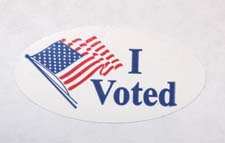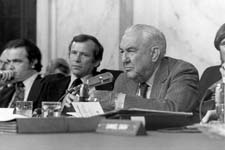

The Timeline highlights significant developments in the history of financial regulation against U.S. and world events. Choose a different decade below, or scroll down to discover more.

In response to the back office crisis, Congress passed the Securities Investor Protection Act, which established the Securities Investor Protection Corporation (SIPC). The Act provided for a fund, financed by fees from broker-dealers, which SIPC administered to protect customer accounts at failed brokerage firms.
The Racketeer Influenced and Corrupt Organizations Act (RICO) allowed private plaintiffs to recover treble damages for injuries by activities, including securities fraud, relating to the conduct of an enterprise through a pattern of racketeering. In 1995, RICO was amended to cut back on securities cases.
Representatives of the securities industry and the New York Clearing House Bank Association formed the Banking and Securities Industry Committee (BASIC) to expedite resolution of the operational problems facing the securities industry. Among BASIC’s achievements was development of a centralized depository system used to immobilize securities certificates, thus permitting intra-firm transfers by book-entry.
In response to a challenge from the Donaldson, Lufkin and Jenrette brokerage firm, the New York Stock Exchange revised its constitution to allow corporate memberships.
The failure of Penn Central was then the largest bankruptcy in the United States. The result of the 1965 merger of the New York Central and Pennsylvania railroads, Penn Central acquired many non-rail businesses in the era of conglomerates. The federal government stepped in to preserve needed rail service: Conrail for freight service, Amtrak for passengers. Subsequent revelations that directors were unaware or unconcerned about widespread mismanagement raised concerns about U.S. corporate governance.
Led by Ralph Nader, activist General Motors shareholders moved to obtain greater proxy access, have directors nominated by various shareholder groups, and require GM to publish information on social policies. While Campaign GM had mixed success, it inspired shareholders at other companies to seek greater influence over corporate policy, especially regarding social responsibility.
The AICPA Accounting Principles Board issued two controversial Opinions on accounting for acquisitions of businesses, the first including criteria for the purchase and pooling-of-interests methods, the second mandating amortization of acquired goodwill over a period not to exceed forty years. The two Opinions could have been issued as one, but would have included so many qualified assents that it might appear not to have the required two-thirds majority. The issues were separated into two Opinions to allow for dissents rather than qualified assents. The process was criticized, and was a factor in studies leading to the Financial Accounting Standards Board.
As a reform to the Investment Company Act of 1940, the legislation restricted sales charges and front end loads, and put new responsibilities on independent fund directors. Section 36(b) held both a fund adviser and the board to a fiduciary duty in regard to investor fees.

The National Association of Securities Dealers automated quote system went on line on February 8, providing market makers with electronic access to pricing information used to conduct manual transactions in a selection of highly-traded stocks.
This study, undertaken by the SEC in response to a sharp increase in investment by banks, insurance, companies, and mutual funds during the 1960s, called for creation of a competitive yet "strong central market system" to equitably accommodate institutional investors.
In direct response to the SEC's recommendation of a competitive central market, former NYSE president and Federal Reserve Chairman William McChesney Martin Jr., prepared a report discouraging competition and recommending that the NYSE become the core of a central market system.
The American Municipal Bond Assurance Corporation began insuring municipal securities offerings. Along with credit ratings, this form of credit enhancement enabled bond buyers to purchase instruments with a reasonable degree of certainty and spurred growth of the market.
The Reserve Fund was established as the first money market fund in the United States, offered to investors interested in preserving capital and earning a small rate of return. Money market funds sought a stable net asset value, generally $1, and aimed never to lose money. During the inflationary 1970s, money market funds enabled investors to exceed regulated bank deposit interest rates.

After conducting hearings prompted by the NYSE Martin Report, the SEC released a "Statement on the Future Structure of the Securities Markets" calling explicitly for markets to be linked and open to competition.
Lewis Powell, a corporate lawyer with a strong background in securities laws, was named a U.S. Supreme Court Associate Justice. He became a powerful voice for securities and financial regulation issues on the Court, challenging the SEC's administrative authority.
To meet the risk-sharing criterion for accounting for a business combination as a pooling of interests under AICPA Accounting Principles Board Opinion No. 16, the U.S. Securities and Exchange Commission established that no affiliate could sell shares until financial results, including a minimum of thirty days of post-merger combined operations, had been published.
The U.S. Securities and Exchange Commission launched an investigation of unethical secondary municipal bond dealers when it brought Rule 10b-5 charges against the firm of Charles A. Morris in Memphis.
Prompted in part by the 1969 Wheat Report, Rule 144 created a safe harbor for the resale of control securities and restricted securities. The rule was subsequently amended to further increase the liquidity of such securities.
On November 14th, the Dow Jones Industrial Average closed above 1000 for the first time.

On April 26, the Chicago Board Options Exchange began trading in listed stock options. The introduction of standardized options provided investors with new hedging opportunities that developed in tandem with computerized trading.
Discovery of massive computer-assisted fraud led to the collapse of Equity Funding. A later AICPA study concluded that generally accepted auditing standards were adequate except for confirmation of insurance in force and related party transactions.
The International Accounting Standards Committee (IASC) was formed to develop the International Accounting Standards. It was succeeded in 2001 by the International Accounting Standards Board (IASB), responsible for developing the International Financial Reporting Standards (IFRS, the new name for International Accounting Standards issued after 2001) and promoting the use and application of the standards.
The Financial Accounting Standards Board, a full-time independent body succeeded the AICPA’s part-time Accounting Principles Board, removing standard-setting from the profession. Overseen by the Financial Accounting Foundation, the FASB included seven full-time members, who were not required to be certified public accountants. The U.S. Securities and Exchange Commission issued Accounting Series Release No. 150, affirming its policy of looking to the private sector for establishing and improving generally accepted accounting principles, and recognizing that standards issued by the FASB would have substantial authoritative support. The blueprint for the FASB was developed by an AICPA-commissioned study, The Wheat Study on the Establishment of Accounting Principles, headed by former SEC Commissioner Francis M. Wheat.
An AICPA study group determined that the primary role of financial reports is to provide information to outside users. The study, Objectives of Financial Statements Report, is known as the Trueblood Report after Touche Ross Chairman Robert M. Trueblood who led the group.

As part of a general reorganization announced April 23, the Division of Enforcement created the Office of Regional Office Assistance and Program Management, soon renamed the Branch of Regional Office Assistance. Directed by former Hugh Owens staffer James Clarkson, the branch promoted consistency across the agency by transmitting regional input to the Commission and conveying Home Office priorities to the regional offices.
The Commodity Futures Trading Commission was given authority by Congress over the trading of all commodities, including commodity-based options, forward, and future contracts. Although the U.S. Securities and Exchange Commission later attempted to expand its jurisdiction over certain security-based financial futures, Congress made it clear that the CFTC would maintain jurisdiction.
Rule 146 created the first safe harbor for the private placement of securities. It was replaced in 1982 by Rule 506, part of Regulation D. Rule 146 expanded the predictability and usefulness of the exemption for intrastate offerings by establishing a safe harbor for transactions meeting certain conditions.
The Employee Retirement Income Security Act (ERISA) established minimum standards for pension plans in private industry and created the Pension Benefit Guaranty Corporation. Its enactment sought to protect the interests of employee benefit plan participants and beneficiaries by requiring disclosure, establishing standards of conduct for plan fiduciaries, and providing for remedies and access to federal courts. By making proxy voting a fiduciary responsibility of pension managers, ERISA extended federal oversight into corporate governance.
The 1973 Watergate hearings revealed illegal corporate payments, bribes and the existence of off-the-books funds, raising questions concerning disclosure and accounting. A year later, the U.S. Securities and Exchange Commission issued Securities Act Release No. 5466, demanding that corporations charged with, pleading guity to, or convicted of violating federal election laws disclose these activities. The SEC then filed a complaint against American Ship Building Company for failure to disclose funds used for political contributions.
Scholars such as William Cary, Harvey Goldschmid and Myles Mace issued critiques of corporate governance practices, observing that the current structure of corporate boards did not provide an effective check on management, and calling for minimum federal standards to bolster state laws.
The Dreyfus Liquid Asset Fund became the first widely-available no-load mutual fund, in which shares were distributed directly by the investment company and sold without a commission or sales charge.

After years of resistance from the New York Stock Exchange, the U.S. Securities and Exchange Commission enacted Rule 19b-3, eliminating, as of May 1, fixed commission rates that allowed the NYSE to maintain its monopoly in the securities markets and significantly reducing transaction costs, especially for large trades. Congress subsequently outlawed fixed brokerage commission rates in the Securities Act Amendments of 1975.
The 1975 Securities Act Amendments gave the U.S. Securities and Exchange Commission responsibility for creating a composite quotation system and for promoting the development of a national system for the efficient clearance and settlement of securities transactions. One of the amendments also required the SEC to amend any rule which imposed an unnecessary burden on competition in the securities markets. This amendment was aimed at NYSE Rule 394 which limited the ability of NYSE members to trade a NYSE listed stock in another market.
New York City was unable to access the public credit markets because of questions about its ability to pay outstanding obligations. New York State set up the Municipal Assistance Corporation (MAC) with a dedicated stream of state revenue that otherwise would have flowed directly to New York City. In July 1975, MAC issued $1 billion in bonds to assist in restructuring New York City’s debt. However, this did not give the city access to new capital. The federal government’s subsequent debt guarantee eventually eased the situation, but cast a further spotlight on municipal financing.
Concerned about the condition of municipal finance, Congress established the Municipal Securities Rulemaking Board (MSRB) as a self-regulatory organization. The MSRB’s purpose was to establish fair practices for underwriting and trading of municipal securities. Both the MSRB and the U.S. Securities and Exchange Commission were prohibited from imposing any pre-issuance filing requirements on municipal issuers. The MSRB was prevented from requiring brokers and dealers to furnish documents related to an issuer unless the information they contained was generally unavailable elsewhere.
In testimony before the U.S. House of Representatives, SEC Commissioner Philip Loomis suggested use of a voluntary disclosure program. Corporations would disclose improper payments made, in lieu of criminal charges being filed; the program would help to protect investors in these companies from financial loss. The first voluntary disclosure took place in September.
In its Statement on Auditing Standards No. 5, the AICPA's Auditing Standards Board provided the first description of the hierarchy of generally accepted accounting principles, including the standards requiring compliance and, in their absence, what should be considered. The Financial Accounting Standards Board issued standards on the GAAP hierarchy, and codified all authoritative standards in 2009.
The U.S. Securities and Exchange Commission instituted a series of Staff Accounting Bulletins (SABs), representing interpretations and practices followed by the Division of Corporation Finance and the Office of the Chief Accountant. SABs were not Commission rules or interpretations, and were not approved by the Commission.

The AICPA-appointed Commission on Auditors’ Responsibilities, known as the Cohen Commission after former SEC Chairman Manuel F. Cohen, discovered a sizeable gap between auditors’ performance and public expectations and made recommendations to close the gap. The study was prompted by several unexpected failures of large companies and the disclosure of questionable and illegal payments made to foreign officials. The spate of alleged audit failures included Westec (1965), Yale Express (1967), BarChris (1968), Continental Vending (1969), National Student Marketing (1969), Penn Central (1970), Stirling Homex (1972), Four Seasons Nursing Homes (1973), and Equity Funding (1973).
Required by Rule 17a-15 under the Securities Acts Amendments of 1975, the composite tape made transaction reports from all auction and electronic exchanges available in a single database.
Materiality, a concept used throughout the securities laws, was defined by the U.S. Supreme Court in TSC Industries, Inc. v. Northway, Inc., a case involving allegations of proxy fraud. The TSC formulation subsequently was recognized for all ’33 and ’34 Act purposes.
The Sunshine Act required certain regulatory agencies, including the U.S. Securities and Exchange Commission, to provide advance public notice of meetings and to open such meetings to the public. The law limited the ability of SEC Commissioners to hold private meetings or to engage in private discussions as a group.
After New York State, New York City, and city labor unions agreed to measures intended to put the city on a sound financial footing, President Ford reversed his initial decision and signed legislation guaranteeing the payment of principal and interest on more than $3 billion of New York City notes and bonds.
The Municipal Securities Rulemaking Board’s first rule-making resulted in the Uniform Practice Rules, codifying and standardizing industry practices for municipal securities trade confirmations, clearance and settlement.
SEC Rule 17d-2 allowed self-regulatory organizations to allocate responsibility among themselves for receiving reports from persons or entities that were members of more than one organization. The rule led the NASD to introduce standardized forms that streamlined the registration process for broker-dealers, investment advisers and issuers. Form BD was the application for registration for broker dealers; Form U-4 served the same function for broker dealer representatives, investment advisers, and issuers. Form U-5 was the notice of termination of registration for market players, alerting investors to disciplinary action. These forms contributed to the creation of the Central Registration Depository (CRD).
The New York Stock Exchange implemented its Designated Order Turnaround (DOT) system to provide direct automated routing of small orders from brokerages to specialists.
Arthur Andersen & Co. petitioned the U.S. Securities and Exchange Commission to withdraw requirements for "preferability letters" from auditors, indicating whether a registrant's accounting change was not only an acceptable alternative, but also - in the accountant's judgment - preferable in the circumstances. The U.S. District Court (Illinois) denied Andersen's motion for a preliminary injunction against the SEC.
The Vanguard Group First Index Investment Trust (now Vanguard 500 Index Fund) opened as the first retail index fund. Index funds sought to match rather than outperform the market by investing in representative stocks. The development of index funds cut the cost of investing and helped to democratize the financial markets.

Enacted by Congress in the aftermath of the Watergate scandal, the Foreign Corrupt Practices Act (FCPA) prohibited bribing foreign government officials, and required publicly-traded companies to maintain accounting and record-keeping systems to control the location of company assets. The FCPA charged the U.S. Securities and Exchange Commission with enforcement of the accounting and record-keeping provisions.
In light of the rapid growth of the options industry, the U.S. Securities and Exchange Commission announced a moratorium on further expansion of options trading, and ordered a review of the market.
The staff of the Subcommittee on Reports, Accounting and Management of the Senate Committee on Government Operations, chaired by U.S. Senator Lee Metcalf (D-MT), issued The Accounting Establishment, dealing with accounting and auditing standard setting, auditor independence and audit quality. The report charged that the "Big 8" audit firms monopolized the auditing of large corporations and the standard-setting process, and recommended that the federal government establish accounting, auditing and independence standards. In 1977, the Metcalf Subcommittee held a series of hearings exploring the report’s findings.
The AICPA founded the SEC Practice Section (SECPS), a membership organization, to oversee the profession’s voluntary efforts at self-regulation. The SECPS established quality control requirements, required each member firm to undergo triennial peer reviews, and reviewed allegations of audit failure to determine if there had been any breakdown in a firm’s quality control system. The five-member Public Oversight Board, created to oversee the SECPS, was funded by SECPS dues and had no disciplinary authority. In February 2001, the POB’s oversight jurisdiction was expanded to include the Auditing Standards Board. On Jan. 20, 2002, the POB voted to disband after SEC Chairman Harvey Pitt announced plans for a new private sector regulatory structure that would have phased out the POB.
The Financial Accounting Standards Board limited accounting by oil and gas producers to the "successful efforts" method, over the protests of smaller companies that favored the "full cost" method. In 1978, the U.S. Securities and Exchange Commission overruled the FASB by allowing either method, and announced that it favored the development of another method: a version of current value accounting. The SEC later agreed to comprehensive disclosures for oil and gas producers developed in 1982 by the FASB, but both "successful efforts" and "full cost" continued to be acceptable accounting methods.
The trustees of the Financial Accounting Foundation (FAF) imposed on the Financial Accounting Standards Board a 4-3 voting majority, versus a 5-2 super majority, to avoid holding up standards. In 1990, the FAF restored the super majority requirement, but reverted back to the simple majority in 2002.
The U.S. Securities and Exchange Commission conducted hearings in and a re-examination of shareholder participation, while Columbia University's American Assembly public issues forum addressed corporate governance. The next year, the American Law Institute launched its Principles of Corporate Governance project to review corporate law and propose reforms.
President Carter appointed Roberta Karmel, a partner at Rogers & Wells, as the first woman SEC Commissioner. She had served in the SEC's New York regional office during the 1960s and as a public director of the New York Stock Exchange.

After two years in development, this year the Commission created the position of Director of Regional Operations within the Office of the Executive Director. Director James Clarkson was responsible for overseeing operation and management of the regional offices. Clarkson also served as an intermediary between the regional administrators and the Chairman.
The AICPA founded the Auditing Standards Board to promulgate standards (Generally Accepted Accounting Standards (GAAS)) for the audits and attestation engagements of all public and non-public entities, as well as quality control standards for CPA firms. After the Sarbanes-Oxley Act of 2002 established the Public Company Accounting Oversight Board and authorized it to set auditing standards for audits of public companies, the ASB continued to set standards for audits (referred to as GAAS) and attestation engagements of non-issuer entities.
The AICPA also created a self-regulatory framework for overseeing the auditing profession that included mandatory peer review, minimum levels of Continuing Professional Education (CPE), audit partner rotation, and second partner concurring review. As well, the AICPA set up disciplinary procedures and sanctions for auditors, the most severe of which was exclusion from the AICPA.
The Subcommittee on Oversight and Investigations of the House Committee on Interstate and Foreign Commerce, chaired by U.S. Representative John Moss (D-Calif.), held a series of hearings on the lack of independence of corporate auditors and the need for outside regulation of accounting and auditing standards. It also issued recommendations for SEC actions to improve the corporate governance function, including the institution of boards and audit committees, and the evaluation and reporting of corporate internal control systems.
A foundational step in creation of a national market system, SEC Rule 11Ac1-1 required all exchanges and market makers to collect and make available best bid and offer information.
In its "yield to maturity" rule, the Municipal Securities Rulemaking Board required bond dealers to provide customers with information on interest rate and maturity date. Rule G-15 gave customers in municipal fixed-income instruments the ability to compare yields and consider alternative investments. The U.S. Securities and Exchange Commission amended its Rule 10b-10 in the mid-1980s to mirror the MSRB rule.
Proposition 13, enacted in California by a 65% majority vote, affected the structure of the municipal securities market. Previously, bonds issued by California issuers were payable from a use tax or fee, but were backed by a pledge to raise property taxes as necessary. Following Proposition 13, valuation was by reference to the relevant use tax or fee revenue stream. This heightened the distinction between general obligation and revenue bonds, accelerating a trend towards the latter. Increased reliance on relatively more complex revenue bonds led to an increase in negotiated sales using a pre-selected dealer, instead of seeking competitive bids from underwriting syndicates. Pre-selection of dealers created the opportunity for corruption in the selection process.
The Leviticus Project, named after the Old Testament book dealing with law, began with the formation of a strike force of securities regulators and law enforcement agencies from seven states to halt the sale of fraudulent investments in the Appalachian coal industry. The project later expanded its reach to investigate fraud in the Texas oil boom of the early 1980s. By the 1990s, with funding support from the federal Bureau of Justice Assistance, the project evolved into a nationwide system for the prevention, investigation and prosecution of economic crimes. In 1992, its name was changed to the National White Collar Crime Center.
Under pressure from the SEC and Congress to allow market linkages, the NYSE and other auction exchanges created “ITS” to provide electronic access to their trading floors.
The U.S. Securities and Exchange Commission released its Special Study of the Options Market. While calling for technical and procedural changes, the study concluded that the market functioned effectively. In 1980, the SEC lifted the options moratorium after exchanges made specified reforms.
The Financial Accounting Standards Board issued its first Statement of Financial Accounting Concepts. The conceptual framework was intended to establish the objectives and concepts that the FASB would use in developing standards of financial accounting and reporting. The FASB would issue seven statements through 2000.
Section 401(k) of the 1978 Tax Reform Act allowed taxpayers a break on taxes on deferred compensation. In the 1980s, benefits consultants used the provision to create a tax-advantaged method to save for retirement. The IRS allowed for tax-deferred salary deductions, making 401(k) retirement plans - along with 403(b) plans for nonprofit institutions and 457(b) plans for government employees - popular.

An AICPA-appointed committee provided guidance to management on assessing and evaluating internal controls and monitoring compliance with established internal control procedures. Entitled Report of the Special Advisory Committee on Internal Accounting Control, but known as the Minahan Report after ARCO Vice President and Controller Eugene J. Minahan, the report concluded that internal accounting control is concerned with the reliability of financial statements and should extend to all external reports of historic financial information.
Under threat of legal action, the AICPA repealed virtually all the profession’s anticompetitive restrictions, including prohibitions on advertising and solicitation between 1972 and 1979. The AICPA entered a consent decree with the Department of Justice in 1972 after a lengthy investigation into the restriction of competition within the profession.
The question of whether a noncontributory, compulsory pension plan constituted a “security” was answered in the negative by the U.S. Supreme Court in International Brotherhood of Teamsters v. Daniel.
The Municipal Securities Rulemaking Board began requiring the use of numbers from the CUSIP (Committee on Uniform Security Identification Procedures) Service Bureau, operated by Standard & Poor’s for the American Bankers Association, on customer confirmations in municipal securities transactions. This alphanumeric coding facilitated the digitizing of information and contributed to additional price transparency.
The U.S. Securities and Exchange Commission recommended that the Financial Accounting Standards Board develop a mechanism for dealing with industry accounting matters in pronouncements from the American Institute of Certified Public Accountants. The FASB decided to exercise responsibility for all such "specialized" accounting by extracting the principles and practices, and issuing them as FASB statements. Up to then, such principles and practices had been considered as preferable for justifying a change as required by generally accepted accounting principles.
Frances Dyleski, with Robert C. Carr & Co., Inc. in Manchester, New Hampshire, became the first woman appointed to the NASD Board of Governors.